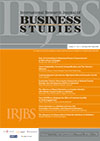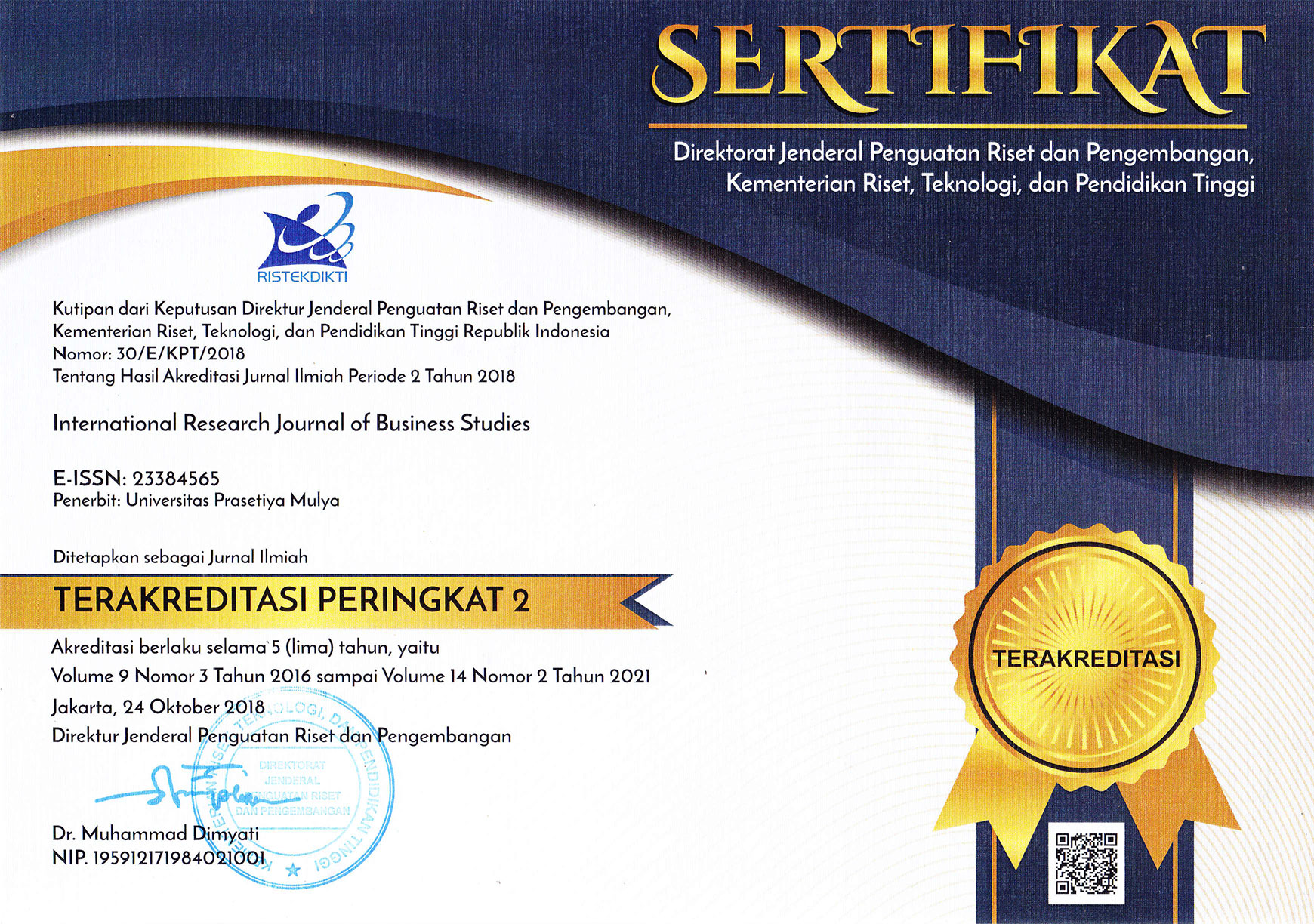The Influence of Innovation and Entrepreneurial Self-Efficacy to Digital Startup Success
DOI:
https://doi.org/10.21632/irjbs.10.1.57-68Keywords:
technopreneurship, entrepreneurial self-efficacy (ESE), innovation, business success, digital startupAbstract
Establishing and developing a startup business is not easy. Startup success depend on various aspects, such as financial, business model, and learning organizations. Personalities factor of founders have a contribution in business development, especially entrepreneurial self-efficacy (ESE) and innovation. But, in Indonesia, there is still no psychological study who see the contribution of those factors on business success in digital startup. This study aimed to understand how both factors influence startup digital. The sample is 64 founders. The research instrument is ESE, KAI, and Business Success questionnaire (Kirton in Riyanti, 2003; Chen et al, 1998; Kaplan & Norton, 2006). Multiple-regression analyses reveal ESE and innovation contributes 20.8% to business success. ESE regression coefficient is 0.200 (P <0.05) and innovation 0.026 (p> 0.05). This means, ESE has significant positive effect, while innovation has a positive relationship but insignificant. Interventions in the form of booklets that inform how to increase ESE. The booklet is already conducted trials on five founders.
References
Arjanti, R. A. & Mosal, R. L. 2012. Startup Indonesia: Inspirasi dan pelajaran dari para pendiri bisnis digital. Kompas Penerbit Buku, Jakarta.
Bandura, A. 2010. Bandura’s instrument teacher self-efficacy scale. Sage Publisher, New York.
Barbosa, S.D., Gerhardt, M.G. & Kickul, J.R. 2007. The role of cognitive style and risk preference on entrepreneurial selfefficacy and entrepreneurial intentions. Journal of Leadership and Organizational Studies. 13(4): 87-104.
Batubara & Tamaria, A. 2016. Pengaruh Efikasi Diri dan Kompetensi Kewirausahaan terhadap Minat Berusaha pada Siswa/I SMK Negeri 10 Medan. Skripsi Sarjana, tidak diterbitkan. Universitas Sumatra Utara, Medan.
Brandstatter, H. 2010. Personality Aspects of Entrepreneurship: A look at five meta-analysis. Journal of Personality and Individual Differences. 10(2): 1-9
Britania, B. & Anggono, A. H. 2014. Analyzing the Factors Affecting Business Performance of Startup Companies in Digital Creative Industry in Indonesia. Journal of Business Strategy and Social Sciences. 1: 566-576
Carlson, M. & Usher, N. 2015. News Startups as Agents of Innovation. Digital Journalism. 4(5): 563-581.
Chen, C. C., Greene, P.G., & Crick, A. 1998. Does entrepreneural self-efficacy distinguish entrepreneurs from managers. Journal of Business Venturing. 13: 295-316.
Crocker, L & Algina, J. 1986. Introduction to Classical and Modern Test Theory. Wadsworth Group, USA.
Drnovsek, M., Wincent, J., & Cardon, M. S. 2010. Entrepreneurial Self-Efficacy and Businness Startup: Deeloping a multidimensional definition. International Journal of Entrepreneurial Behaviour & Research. 16(4): 329-348.
Herath, H. M. A. & Mahmood, R. 2014. Dimensions of Entrepreneurial Self-Efficicacy and Firm Performance. Global Journal of Management and Bussiness Research. 14(4): 22-30.
Inggarwati, K. & Kaudin, A. 2010. Peranan Faktor-faktor Individual dalam Mengembangkan Usaha: Studi kuantitatif pada wirausaha kecil di Salatiga. Jurnal Manajemen Bisnis. 3(2): 185-202.
Jones, C. & Shao, B. 2011. The Net Generation and Digital Natives. A Literature Review Commissioned by the Higher Education Academy. Open University Review in United Kingdom. 1 – 56.
Kaplan, R. S. & Norton, D. P. 1996. The Balance Scorecard: Translating strategy into action. Harvard Business School Press, Amerika Serikat.
Langen, F. & Groenewegen, G. 2012. Critical Success Factors of the Survival of Start-Ups with a Radical Innovation. Journal of Applied Economics and Business Research. 2(3): 155-171.
Leutner, F., Ahmetoglu, G., Akhtar, R., & Premuzic, T. C. 2014. The Relationship Between The Entrepreneurial Personality and The Big Five Personality Traits. Journal of Personality and Individual Differences. 58 – 63.
Nann, S., Krauss, J., Schober, M., Gloor, P. A., Fishbach, K., & Fuhres, H. 2009. The Power of Alumni Networks - Success of
Startup Companies Correlates With Online Social Network Structure of Its Founders. Journal MIT Sloan Research Paper. 1: 1-28.
Rauch, A. & Frese, M. 2007. Let’s put the person back into entrepreneurship research: A meta-analysis on the relationship between business owners’ personality traits, business creation, and success. European Journal of Work and
Organizational Psychology. 16(4): 353 – 385.
Riyanti, B. P. D. 2003 Kewirausahaan dari Sudut Pandang Psikologi Kepribadian. Grasindo, Jakarta.
R., S., E., & T. Pelaku Usaha Bisnis Startup Digital Aplikasi. Interview on 16-17 November 2016.
Seibert, S. E. & Zhao, H. 2006. The Big Five Personality Dimensions and Entrepreneurial Status: A meta-analytical review. Journal of Applied Psychology. 91(2): 259-271.
Senge, P. M. 2010. The Fifth Discpline: The art and practice of the learning organization. Doubleday, New York.
Sivalingan, K. M. & George, N. R. 2011. Next Generation Internet: Architectures and protocols. Cambridge University Press, New York.
Song, M., Podoynitsyna, K., Hand, V. D. B., Halman, J. I. M. 2008. Success Factors in New Ventures: A meta-analysis. The Journal of Product Innovation Management. 25(1): 7-27.
Spector. P. E. 2012. Industrial and organizational psychology: Research and practice. (6th Ed.). John Wiley & Sons, Singapore.
Startup Genome Report. 2012. A New Framework for Understanding Why Startup Succeed. Literature Report in Bekeley and Standford. 1 – 67.
Sugiyono. 2010. Metode Penelitian Kuantitatif, Kualitatif, dan R&B. Alvabeta, Bandung.
York, J. L. & Danes, J. E. 2014. Customer Development, Innovation, And Decision-Making Biases In The Lean Startup. Journal of Small Business Strategy. 24(2): 21-39.
Tagraf, H. & Akin, E. 2009. Relations Between the Charateristics of Entrepreneurship and The Bussiness Owner: An analysis of SME’S in Konya. Serbian Journal of Management. 4(2): 239-257.
Zaheer, H. 2015. How Do Innovative Digital Start-Ups Achieve Success? Perspectives Of Australian Founders. Disertasi. Universitas Macquarie, Australia.
Zuliarni, S. 2014. Analisis Kreativitas dan Inovatif Pengusaha Industri Kreatif Sub Sektor Kerajinan di Pekanbaru. Jurnal Aplikasi Bisnis. 4(2): 110-123
Downloads
Submitted
Published
How to Cite
Issue
Section
License
Copyright (c) 2017 Agnes Dessyana, Benedicta Prihatin Dwi Riyanti

This work is licensed under a Creative Commons Attribution-ShareAlike 4.0 International License.
Journal Author(s) Rights
For IRJBS to publish and disseminate research articles, we need publishing rights (transferred from the author(s) to the publisher). This is determined by a publishing agreement between the Author(s) and IRJBS. This agreement deals with the transfer or license of the copyright of publishing to IRJBS, while Authors still retain significant rights to use and share their own published articles. IRJBS supports the need for authors to share, disseminate and maximize the impact of their research and these rights, in any databases.
As a journal Author, you have rights to many uses of your article, including use by your employing institute or company. These Author rights can be exercised without the need to obtain specific permission. Authors publishing in IRJBS journals have comprehensive rights to use their works for teaching and scholarly purposes without needing to seek permission, including:
- use for classroom teaching by Author or Author's institution and presentation at a meeting or conference and distributing copies to attendees;
- use for internal training by the author's company;
- distribution to colleagues for their research use;
- use in a subsequent compilation of the author's works;
- inclusion in a thesis or dissertation;
- reuse of portions or extracts from the article in other works (with full acknowledgment of the final article);
- preparation of derivative works (other than commercial purposes) (with full acknowledgment of the final article);
- voluntary posting on open websites operated by the author or the author’s institution for scholarly purposes,
(But it should follow the open access license of Creative Common CC-by-SA License).
Authors/Readers/Third Parties can copy and redistribute the material in any medium or format, as well as remix, transform, and build upon the material for any purpose, even commercially. Still, they must give appropriate credit (the name of the creator and attribution parties (authors' detail information), a copyright notice, an open access license notice, a disclaimer notice, and a link to the material), provide a link to the license, and indicate if changes were made (Publisher indicates the modification of the material (if any) and retain an indication of previous modifications.
Authors/Readers/Third Parties can read, print and download, redistribute or republish the article (e.g. display in a repository), translate the article, download for text and data mining purposes, reuse portions or extracts from the article in other works, sell or re-use for commercial purposes, remix, transform, or build upon the material, they must distribute their contributions under the same license as the original Creative Commons Attribution-ShareAlike (CC BY-SA).
This work is licensed under a Creative Commons Attribution-ShareAlike 4.0 International License.








